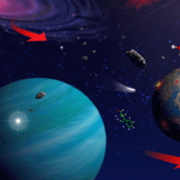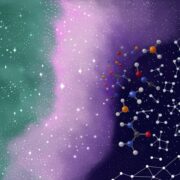Title: Complex networks in interaction: Theory and astrobiological applications (NetWorld).
Reference: Plan Nacional de I+D+I. Referencia PID2021-122936NB-I00.
Funding entity: Ministerio de Ciencia e Innovación de España.
Principal investigators: Jacobo Aguirre Araujo (CAB), Raúl Guantes Navacerrada (UAM).
Research team: Marina Fernández-Ruz (CAB), Carla Alejandre Villalobos (CAB), Prof. Serena Viti (Leiden Observatory), Prof. Sebastian Ahnert (Univ. Cambridge), Dr. Fernando Puente (Sveriges lantbruksuniversitet, Uppsala, Sweden).
Complexity & Astrobiology Group Webpage: http://complexityweb.com/aguirre/

INTRODUCTION
The interaction, collaboration and competition between different agents represent the main driving forces behind the evolution of the biological, sociological and technological systems that surround us. Most of the systems that evolve in the Universe are based on cooperation and/or competition for resources that are always limited, and many of them are so complex that to represent them accurately we must use networks formed by a multitude of nodes and their interactions. This phenomenon is also observed in environments outside our planet, such as the interstellar medium, where its main components (atoms, molecules, dust and energetic processes), are in continuous interaction and evolution.
From this perspective, we propose a novel project where we aim to create a bridge from the theory of complexity to astrobiology to shed light on one of the most challenging scientific contexts of our century: the origin of life and its evolution towards complexity in our planet. In particular, we will start by creating a general theoretical framework for analysing the processes in which different networked agents interact and compete for resources, both in constant or evolving environments. And then we will assess the usefulness of this theory in the analysis of open problems related to the origin and the evolution of life on Earth.
OBJECTIVES OF THE PROJECT
Objective 1: The first objective consists of the development of a general theoretical and methodological framework, which we will call Theory of Interacting Networks, which will serve to mathematically describe the interaction between systems that can be described as complex networks and their evolution in different environments.
Objective 2: The second objective will be the application of the theory to three systems of large astrobiological interest:
- Study of the formation in the interstellar medium of more or less complex organic compounds of relevance for prebiotic chemistry, trying to shed light on the reactions that take place in them and in the calculation of their abundances, a problem of maximum importance for astrochemistry.
- Study of the first prebiotic chemical processes that took place on Earth from these compounds (brought to its surface by the impact of meteorites and comets) and that gave rise to the origin of life, from the perspective of artificial life but using a novel approach to be able to discern if the basic properties of life -such as the creation of diversity, inheritance and replication- can emerge naturally in a sufficiently simple model, without the need to introduce them ad hoc as has been done so far in the literature.
- The third field will be the study of networks that are much more complex than the previous ones, and within the framework of current biochemistry: we will focus on the interactions between protein networks of various viruses and the protein network of their host cells throughout the infection process.









